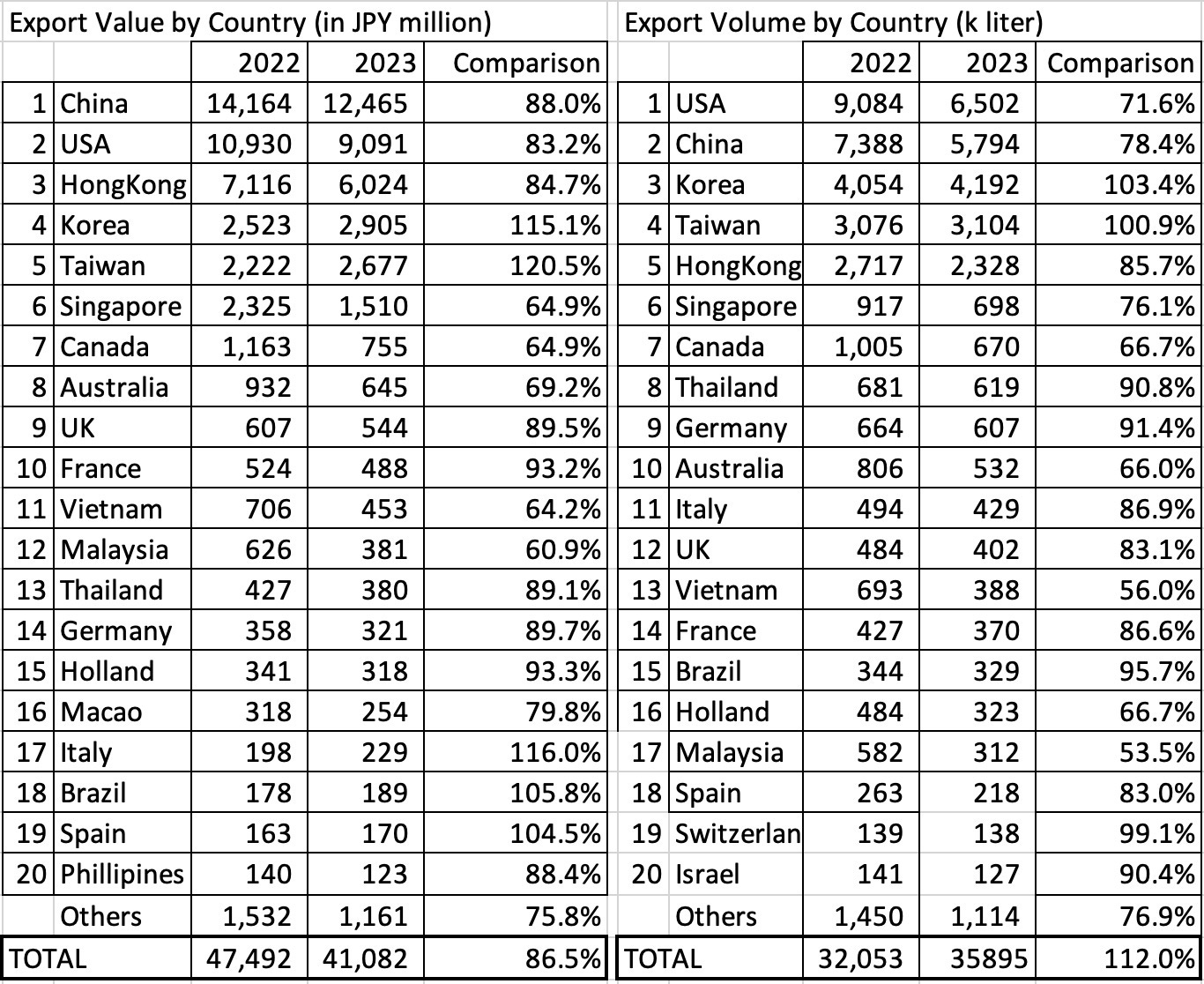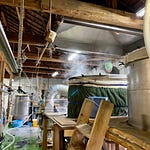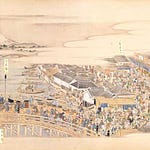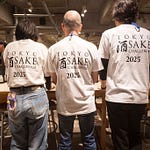Welcome to Issue #106 of SIN.
Believe it or not, spring is almost upon us. It’s cold enough here in Japan for that to sound outrageous, but the calendar doesn't lie. And to back it up, the first spring sake releases are already appearing.
Speaking of making an appearance, Japan was recently treated to an appearance of the world’s biggest music star, when Taylor Swift herself performed for four nights at Tokyo Dome. Of course anything Tay Tay does makes the news, so it was a nice surprise when her name was mentioned in the news alongside “sake”.
How? Well, it seems one particularly grateful gentleman gifted Taylor Swift four bottles of Tatenokawa sake valued at USD4000 each as a show of appreciation for making his daughter so happy.
Will Taylor Swift drink those bottles of sake? Possibly not. Who knows?
She was seen chugging a beer at the Superbowl so we know she likes a drink.
Either way, it’s always great to see sake gaining national attention even if via celebrity power. Sure, we know that sake doesn’t need the approval of famous people to validate how good it is, but every bit helps, and if Taylor Swift became a sake fan it would be a big deal.
It doesn't matter whether you’re a Swiftie, a Belieber, a member of BTS Army, a Little Monster, a Sheerio or even a Deadhead, there’s no need for us to gatekeep how people find sake. At the end of the day it doesn’t matter how people discover sake, just that they do.
And now for the news…
Salvaged Sake ContInues To Blossom
Hyogo- On January 17, SAKE HUNDRED began taking reservations for the 120 bottles being released of 29-year old vintage sake, Gengai.
When the Hanshin Awaji Earthquake hit in 1995, Sawanotsuru was one of many breweries in the Kobe region that suffered great damage and lost a lot of sake.
However, the brewery did manage to salvage a couple of tanks of shubo (starter mash).
With further brewing impossible to undertake, the shubo was pressed as is, however the quality and flavor profile deemed it unfit for release. The bottles were kept aside and slowly aged at cool temperatures over the years once the brewery was functional again.
Brewers at Sawanotsuru continued to monitor the development of the sake over the years as the flavors deepened and mellowed. In 2019, a number of bottles Gengai were released as a 24-year aged sake and promptly sold out in just 12 hours.
Sawanotsuru is now releasing 120 bottles of Gengai through SAKE HUNDRED in support of the recent earthquake in Ishikawa Prefecture by donating a portion of sales to relief organizations.
This release of Gengai is retailing for JPY266,200 (USD15K) per 500ml bottle.
Source - Amagasaki
JG: I like the sheer tenacity of spirit that is behind this product. And while certainly not cheap, it will surely reward those that choose to indulge. The fact that it is only shubo, i.e. the stage before most of the rice, water and koji were added, and then aged so long, it is clearly going to be a very unique item. I am sure it is unprecedented as a market product.
現外 , 沢の鶴
The Changing Face Of Kochi Sake
Kochi- Kochi sake has long been known for its clean and dry character, however a unique yeast strain is continuing to challenge this image.
Kameizumi Shuzō has been brewing sake using the slightly controversial CEL-24 yeast since 1998. At first the idea was to produce a wider range of styles among the brewery’s portfolio, however when its CEL-24 yeast began to increase in popularity - particularly with those that don’t normally drink sake, production of its CEL-24 junmai ginjō ended up accounting for 70% of the brewery’s total production.
CEL-24 was developed by the Kochi Industrial Technology Center in 1993. Haruhiko Uehigashi, who was involved in the development more than 30 years ago commented that initially many breweries did not wish to use CEL-24 as the aroma was too strong. Kameizumi and Takagi Shuzō were the only two breweries to embrace the peculiar strain.
However, as sake exports increased, Kameizumi Shuzō garnered more attention when its CEL-24 junmai ginjō took the top award at a sake competition held in Beijing in 2018. As Kameizumi’s popularity overseas increased, so did the interest of other Kochi-based producers in using CEL-24.
Furthermore, the COVID pandemic gave breweries with excess stock of sake rice the opportunity to try new styles of sake. Now, out of 18 sake brewers in Kōchi, 11 are using CEL-24.
Kazuhito Saibara of Kameizumi Shuzō, remarked, “Finally the times have caught up with us.”
Akihiko Takemura, director of Kochi Sake Brewers Association and president of Tsukasabotan Shuzō, says that sake produced with CEL-24 yeast is a nice addition to the Kochi sake repertoire, but it will not replace the clean and dry style of sake for which Kochi Prefecture is known.
Source - Mainichi
JG: Having recently worked with Kochi prefecture on a couple of projects, I was reminded how interesting the range of new-ish Kochi yeasts can be. Kochi has the driest sake in Japan, chemically speaking. And that is true whether you measure that by the specific gravity (nihonshu-do) or by glucose content. Yet the array of esters and aromas combined with the acidity created by those yeasts make the sake taste decidedly sweet. So if it tastes sweet, it is sweet… right? Hm. You have to make that call yourself.
亀泉酒造 , 高木酒造(豊能梅), 司牡丹酒造
Sōgen Sells Out
Ishikawa- Sōgen Shuzō released Fukko no Sake (sake for recovery) at the beginning of February - a month on from the Noto earthquake.
Founded in 1768, Sōgen Shuzō suffered JPY200 million (USD1.3mil) worth of damage in the earthquake including inventory loss and structural damage.
Shortly after the earthquake, brewers resumed manual pressing via fukurozuri/shizuku) methods of the surviving tanks - without electricity and running water in the brewery.
On February 1, all of the 500 sets made up of two bottles priced at JPY25k were released online and promptly sold out within 30 minutes.
The brewery will donate JPY10k per set sold to the Suzu City office for relief funds.
Source - Yomiuri | Newsdig
JG: Sogen is such a representative sake of the Noto region, and with such a solid presence (much like the sake itself!) that I am not at all surprised how soon that sold out. Like all people and sake breweries from the Noto region, let us support in any and all ways that we can!
宗玄酒造 , 復興の酒
Spring Is Here Again
Japan- On February 4, 43 breweries from 35 prefectures released their Risshun Asa Shibori sake.
Risshun is the name given to the first day of spring according to the traditional lunisolar calendar. It was also once considered the beginning of the New Year.
While spring officially begins in Japan in March, risshun is still a popular time for some breweries to release their special spring offerings. Since 1998, sake bearing the official risshun label has been pressed on the morning of risshun and available as nama genshu that evening.
For the brewers it requires meticulous planning to be sure the sake will be in prime condition precisely on that particular morning and ready to be pressed. Also for the brewery workers it is often a mad dash to get the sake bottled and labeled ready for shipping on the same day.
JPY1980 (USD15) per 720ml bottle.
Source - Tokyo NP | Meimonshu
JG: The Risshun event and sake from the Meimonshukai group seem to be growing in significance and momentum. Sake has always had seasonal offerings so it is great to see somewhat new traditions being born that continue in that vein.
Export Analysis & JSS Report
Japan- Slightly concerning news ahead as sake export by value declined in 2023 compared to the previous year for the first time in the last 14 years.
According to the trade statistics from the Ministry of Finance, the total value of export of 2023 came in at just over JPY41billion (USD275mil), down 13.5% compared to 2022.
The biggest importer China suffered from an economic slowdown and poor relations due to Japan’s release of treated water from nuclear reaction-affected Fukushima into the ocean. As China ceased imports of Japanese seafood, sake volume declined by 50% compared to the previous year in August to November. By December exports had recovered to about 70%, but still remained relatively low.
Global inflation also played a role in a slump in US imports where export volume dropped to 29,196 kilo liter - an 18.7% decline
In 2021, exports increased by 66% and in 2022 by 18%, however these figures are based on the shipments rather than actual sales. It was this gap between actual demand/sales and shipment that highlighted the decline in 2023. In 2022, as the issue of container shortages was resolved, a number of importers requested more volume than they could actually sell in order to build up inventory. The lag in time it took some suppliers to move this inventory led to the lower shipments in 2023.
Exports to Singapore dropped by 35%, however this drop has been partly attributed to wealthy Singaporeans visiting Japan and consuming sake here. South Korea on the other hand, still saw an increase in sake imports even as more South Koreans visited Japan.
In the short term, China’s recovery remains the key to healthy exports, however in the mid to long term, inbound tourists are being viewed as one way to encourage further demand from overseas markets.
-JSS Country By Country Analysis For 2023-
China came in as the top export market by value at JPY 12.47 billion (USD83mil), 12.% down compared to 2022.
Hong Kong saw exports of JPY 6.02billion (USD41mil) down 16%.
Listen to this episode with a 7-day free trial
Subscribe to Sake Industry News to listen to this post and get 7 days of free access to the full post archives.














